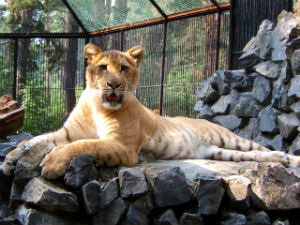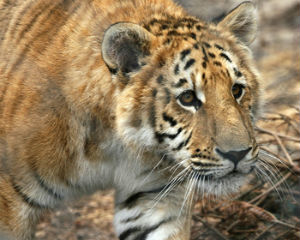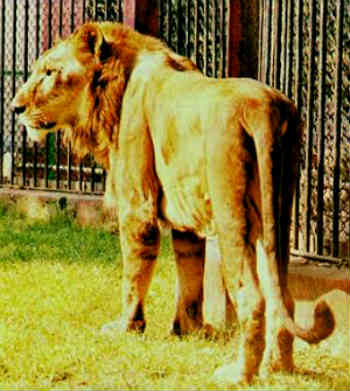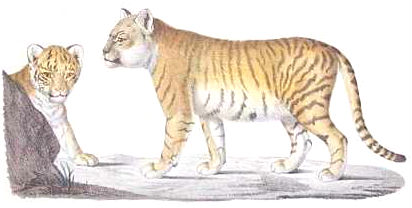Liger (Lion x Tigress)
Mammalian Hybrids

 Ti-liger, a backcross hybrid produced by mating a male tiger with a ligress (lion × tigress)
Ti-liger, a backcross hybrid produced by mating a male tiger with a ligress (lion × tigress)
A hybrid between a lion and a tigress is known as a liger (the reciprocal cross, tiger × lioness, produces what is known as a tigon). This cross has occurred many times in captivity.
And if the lion is the king of beasts, then the liger must be the king of cats. Ligers, especially males, can be far larger than either lions or tigers, sometimes as large as both of their parents together, up to 1,250 lbs (470 kg). The largest cats in the world, they stand about 12 feet (3.66m) tall on their hindlegs. Ligers are much larger, and far more common than tigons because breeders prefer their larger size, which affords a more sensational exhibit (tigons are often smaller than either a lion or a tiger, usually weighing no more than 350 lbs = 160 kg). Also, P. tigris males cross less willingly than P. leo males. The female hybrids are able to produce offspring in backcrosses with both lion and tiger males.
 A li-tigon, a backcross hybrid produced by mating a lion with a ligress. This animal was held in the Alipore Zoo, Calcutta, during the 1980s. Credit: Alipore Zoo, Karl Shuker and Shubhobroto Ghosh. More information >>
A li-tigon, a backcross hybrid produced by mating a lion with a ligress. This animal was held in the Alipore Zoo, Calcutta, during the 1980s. Credit: Alipore Zoo, Karl Shuker and Shubhobroto Ghosh. More information >>
The mane of a male liger is smaller than that of a pure lion (tigons often have no mane at all). Their stripes are brown instead of black, on a background of intermediate tone. They can make the sounds of both a lion and a tiger (in general, it is typical for the offspring produced by any given type of hybrid cross to produce vocalizations that are a mixture of the vocalizations of the two parents participating in that cross). Like tigers, ligers lack a lion’s aversion to water.
Courtney (1980, p. 22) says there have been rare reports of natural hybrids. In the past, when tigers and lions were far more common than today and frequently came into potential breeding contact, natural hybridization may well have been frequent. Today, these cats co-occur only in India’s Gir Forest, but their ranges formerly overlapped widely in Asia.
Article continues below
 Above: An early illustration of two ligers (Geoffroy St. Hillaire, 1799)
Above: An early illustration of two ligers (Geoffroy St. Hillaire, 1799)
This cross has long been known and has been bred in zoos and for circuses the world over. It was reported as early as 1788 (Trewman’s Exeter Flying-Post, July 31), and in India there is a long tradition of breeding these hybrids. An Indian princess gave one to Queen Victoria upon her accession in 1837. Nevertheless, the Indian government recently (1985) passed legislation forbidding their production.
Were cave lions ligers? Noting that the cave lion, a massive cat (400-500 kg) that existed during the Pleistocene in Eurasia, has been classified both as a type of lion and as a type of tiger and that it has osteological traits that link it to both, Rousseau suggests it may have been a natural hybrid of this type, and notes that the skeletons of cave lions, particularly the mandibles, are similar to those of known hybrids. The cave lion has been treated as a species (Panthera spelea).
By the same author: Handbook of Avian Hybrids of the World, Oxford University Press (2006).
At left: A tigon cub held in the collection of the University of Pavia, birthed in Milan by a lioness mother and donated to the Museum of Pavia in 1831 by Rainer Joseph, Archduke of Austria and Viceroy of the Kingdom of Lombardy-Venetia from 1818 to 1848.
Sources: Ackermann 1898; Antonius 1951; Boettger 1896; de Lavison 1863; Eifrig 1937; Flower 1929a (p. 79); Ghosh et al. 2017; Gray 1972; Hemmer 1966† (Figs. 71, 72, 73, 74, 77); International Zoo Yearbook 1970 (p. 266), 1971 (p. 277), 1974 (p. 383), 1981 (p. 323); Jardine 1834-1843†; Kemna 1953; Leyhausen 1950†; Mitchell 1930; Noack 1908a, 1908b†; Peters 1978; Rörig 1903; Rousseau 1971†; Seifert and Grummt 1982; Shuker and Ghosh 2017. Internet: tinyurl.com/y7uc83qh. Pictures: tinyurl.com/jnz669a, tinyurl.com/had9skq, tinyurl.com/28zbd5y.
Most shared on Macroevolution.net:
Human Origins: Are we hybrids?
On the Origins of New Forms of Life
Mammalian Hybrids
Cat-rabbit Hybrids: Fact or fiction?
Famous Biologists
Dog-cow Hybrids
Georges Cuvier: A Biography
Prothero: A Rebuttal
Branches of Biology
Dog-fox Hybrids